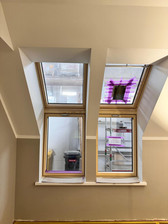The Importance of Natural Light and Fresh Air in Sustainable Housing Design - VELUX
- Kaspars Senvalds

- Oct 21, 2024
- 5 min read
Updated: Feb 10
Natural light and fresh air are essential elements that contribute to both physical and mental well-being, playing a critical role in planning sustainable housing. Natural light enhances mood and productivity, reducing the need for artificial lighting and minimizing environmental impact. Fresh air, on the other hand, creates a healthier indoor climate, improving respiratory health and reducing allergy risks.
When designing a home, it's important to ensure optimal lighting in different rooms and to provide opportunities for natural ventilation. In this article, we explore the benefits of daylight and fresh air, as well as the optimal lighting requirements for various rooms, to inspire you to create a healthy indoor climate in an environmentally friendly way.

Prefabricated Modular Structures
VELUX windows, known for their energy efficiency, superior insulation, and ability to bring in abundant natural light, can be seamlessly incorporated into prefabricated structures. In modular designs, where flexibility and space optimization are key, VELUX windows allow for better airflow and improved daylighting, enhancing both the aesthetic and functional aspects of the building. Their adaptability makes them an ideal choice for prefabricated buildings, as they can be integrated into roofs or walls without compromising structural integrity.
Benefits of Natural Light
Enhancing Physical and Mental Health: Natural light plays a key role in improving our physical and mental health. It helps regulate circadian rhythms, essential for sleep quality and daily energy levels. People exposed to adequate natural light often experience better sleep and less stress. Additionally, it promotes vitamin D synthesis in the skin, crucial for bone health and immune system support. Studies also show that daylight improves mood and reduces symptoms of depression and anxiety. Incorporating sufficient natural light into homes can thus enhance overall well-being and quality of life. In planning, ensure rooms are well-lit with windows. To optimize lighting conditions, combine vertical windows with skylights.
Cost Savings: Incorporating natural light into home design not only improves health but also offers energy savings. Properly planned spaces can significantly reduce artificial lighting costs, lowering electricity bills and reducing carbon emissions, supporting sustainable living. Natural light also improves energy efficiency, as sunlight helps maintain warmth, reducing heating costs in colder months. These investments increase property value, making homes more attractive to potential buyers. Therefore, it's worth considering architectural and design solutions that maximize daylight, ensuring both comfort and financial savings.
Environmental Impact of Natural Light: Using daylight in homes provides significant environmental benefits. By reducing reliance on artificial lighting, we can significantly lower energy consumption, thereby reducing fossil fuel use and greenhouse gas emissions. This is a crucial step in combating climate change and promoting sustainable energy practices. Additionally, reduced electricity demand lessens the strain on energy production infrastructure, which can harm natural ecosystems. By increasing the amount of natural light in rooms, we also decrease the need for artificial lighting, which often involves materials harmful to the environment. Thus, natural light not only improves quality of life but also helps protect and preserve the planet's resources and ecosystems, supporting sustainable development on all levels.
Benefits of Fresh Air
Improving Health and Preventing Disease: Fresh air is a key factor in enhancing health and preventing illness. It provides better oxygen delivery to the body, improving brain function and concentration. Fresh air can also alleviate respiratory issues by helping to clear lungs of harmful substances and allergens that accumulate in enclosed spaces. Additionally, it strengthens the immune system, helping the body fight infections more effectively and reducing the risk of respiratory diseases. Regular ventilation and the influx of fresh air help control humidity levels, reducing the risk of mold and other harmful microorganisms.
Reducing Energy Consumption: Naturally ventilating spaces can significantly reduce energy consumption. Effective ventilation helps maintain optimal indoor temperatures, reducing the need for artificial heating and cooling systems. This not only cuts electricity and other energy costs but also reduces emissions that contribute to climate change. Ensuring adequate fresh air flow also prevents moisture buildup, which can damage a building’s structure and lead to costly repairs.
The Role of Fresh Air in Sustainable Housing: Fresh air is a key element in promoting sustainable housing design and operation. It ensures healthy indoor air quality, critical for residents' well-being and health. Fresh air helps remove pollutants and moisture, which can cause mold and other harmful substances. By integrating efficient ventilation systems, we can reduce the energy needed for climate control, lowering the home's carbon footprint. Sustainable homes often use natural ventilation solutions, such as strategically placed windows and vents, that ensure effective airflow without additional energy consumption. This approach not only promotes energy efficiency but also helps reduce overall operational costs. Fresh air is essential to creating homes that are both healthy and sustainable, meeting modern demands for greener and more environmentally friendly living spaces.
Optimal Lighting for Different Rooms
Living Room Lighting Levels: The living room is where family and friends often gather, so it's important to ensure sufficient and adaptable lighting. The optimal light level for this space is 500 LUX, supporting comfort and a variety of activities, such as reading, relaxing, or entertaining. Daylight is ideal, as it provides even and pleasant light distribution during the day. Plan for south- or east-facing windows to maximize daylight and enjoy the sunlight flowing into the room. In the evening, adjustable artificial lighting options like ceiling or floor lamps with dimmers are recommended to adjust light intensity according to needs and mood. Design solutions that incorporate various light sources can create a dynamic and functional living environment suitable for both work and relaxation.
Kitchen Lighting Requirements: The kitchen is one of the most functional spaces in the home, and its lighting must meet specific requirements for both practicality and safety. A well-lit workspace is crucial, with a recommended light level of 500 LUX for cooking, while 300 LUX is ideal for dining. Skylights provide three times more daylight than vertical windows, so consider incorporating them into kitchen design to let in ample light. Skylights also allow quick ventilation of moisture and odors from cooking. Under-cabinet lighting is a great complement to natural light, directly illuminating work areas and reducing shadows, making cooking safer and more comfortable. Decorative lighting can add an aesthetic touch, highlighting specific design elements. When choosing kitchen lighting, consider both the efficiency of light sources and the color temperature to create a pleasant and functional environment for daily tasks.
Bedroom Lighting Needs: Bedroom lighting plays a crucial role in creating a calm and restful environment. The key is balancing functionality and comfort. The recommended light level in the bedroom is 500 LUX. Plenty of daylight and a view through skylights visually enlarge the space. In the evening, ensure soft and calming lighting to promote relaxation and prepare the body for sleep. We recommend installing blackout blinds on skylights to ensure uninterrupted sleep from moonlight or street lamps. In addition to general room lighting, bedside lamps or wall sconces provide adequate reading light. Adjustable lamps with dimmers allow for customizing light intensity according to needs.
Every home is unique, just like its residents. Tailor natural light and fresh air solutions to your specific needs and lifestyle. Consult professionals to find the best solutions for your home. Remember, a healthy and sustainable home is an investment in your future and for future generations.
By incorporating VELUX window systems, modular prefabricated buildings not only achieve greater sustainability but also enhance the comfort, health, and well-being of the occupants, creating a more natural, energy-efficient living environment. This makes them a valuable addition to modern modular homes and boutique hotels seeking to offer a blend of luxury and environmental consciousness.
Find out more information here:
Daylight visualizer – free software where you can test the quality of natural light. https://www.velux.lv/profesionaliem/riki/arhitektiem/daylight-visualizer
"DESIGN BOOKLET. GUIDELINES FOR PROFESSIONAL HOUSE BUILDERS AND ASSOCIATED PARTNERS: ARCHITECTS, ENGINEERS & INSTALLERS"

















Lai uzzinātu vairāk par dabiskā apgaismojuma un svaiga gaisa nozīmi ilgtspējīgā mājokļu projektēšanā, lasiet pilnu rakstu šeit: <a href='https://jakarta.telkomuniversity.ac.id/en/mother-for-family-resilience/'>klik di sini</a>.